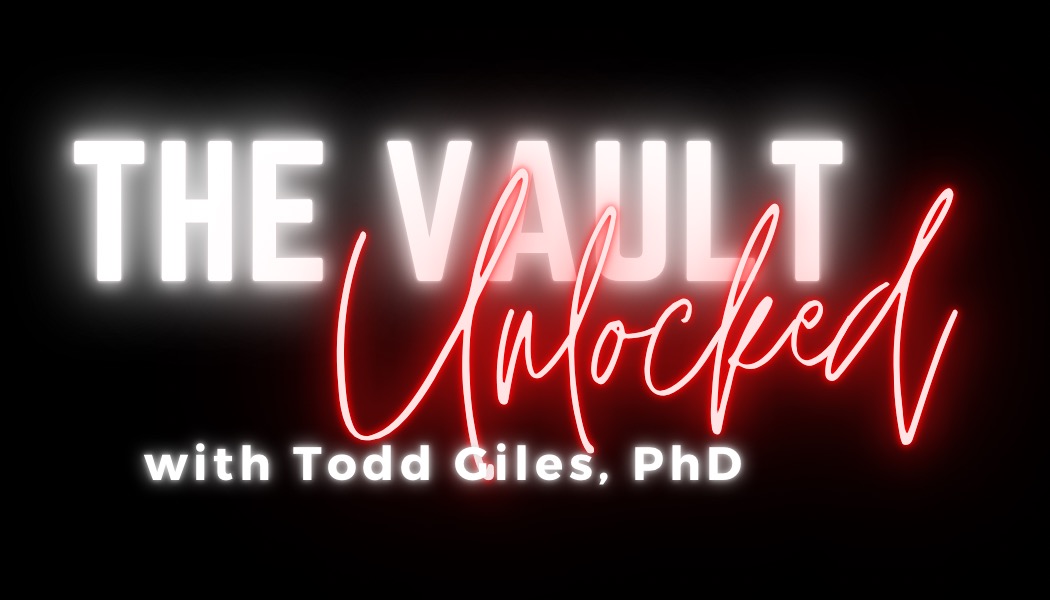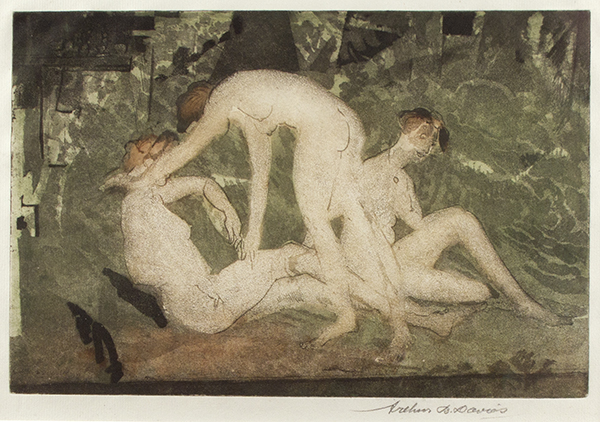
Ever wonder where the art is stored at the WFMA, and what's in there anyway? Join MSU professor Todd Giles as he unlocks the vault!

Arthur Davies
Against Green, 1924
Soft ground etching with aquatint
17 13/16 X 11 7/8 in.
Signed lower right
Sixth and final state; circa 10 printed
Printed by Frank A. Nankivell
Museum purchase, 1978
[Transcript]
Hello and welcome to The Vault Unlocked. My name is Todd Giles and we’re here to take you inside the collection vault at the Wichita Falls Museum of Art at MSU Texas. In this episode, we will take a close look at Arthur Davies’ 1924 soft ground etching titled Against Green.
Arthur B. Davies (1862-1928) is one of those figures, like American author Gertrude Stein, who had an enormous impact on the arts during the early 20th century, only in Stein’s case, it was her forward-looking imagination that was impactful, whereas in Davies’, it wasn’t his art but what he did for art that left its mark. While Stein embraced the modernist rhetoric of Cubism flourishing at the time, Davies’ was an art of the past, steeped in romance and fantasy. He did briefly flirt with Cubism, but only in passing and rather awkwardly.
Davies was born in Utica, New York in 1862; at sixteen, he moved with his family to Chicago, where he studied for three years at the Chicago Academy of Design. Back in New York in 1886, he further honed his craft at the Art Students League and, like many of the soon-to-be famous artists of his day, worked for several years as a magazine illustrator. Some of those artists, including Davies himself, were part of a group known as The Eight, artists who, in tried and true art historical fashion, protested the restrictive practices of the artistic name-making powerhouse in the US at the time—the National Academy of Design. Three of those artists are likewise housed in the permanent collection of the WFMA with Davies: John Sloan, William Glackens, and Robert Henri.
What Davies did for art—American art in particular—was to take a lead role in organizing and promoting the Armory Show in New York in 1913. The exhibition, which was also organized by Davies’ friends Walt Kuhn and Walter Patch, was made up of some of the most groundbreaking European art of the day by Cubists, Fauvists, and Futurists, including works like Marcel Duchamp’s Nude Descending a Staircase No. 2. Along with avant-garde artists like Picasso, Cezanne, and Matisse, the exhibition also included several already established artists from the late 19th century such as Monet, Toulouse-Lautrec, and Van Gogh.
The Armory Show also exhibited some American artists, including several held in the WFMA’s collection: George Bellows, Mary Cassatt, Stuart Davis, William Glackens, Childe Hassam, Robert Henri, Edward Hopper, John Marin, Charles Sheeler, John Sloan, and Arthur Davies himself. What the Armory Show showed American artists and collectors was just how behind the times American art was compared to that being produced throughout Europe. It helped Americans shake the dust off and, eventually, take on the avant-garde mantle some thirty years (and two world wars) later with Abstract Expressionism.
As mentioned above, though Davies was at the forefront of understanding and promoting contemporary trends in art, his own work had more in common with the Pre-Raphaelites, James McNeill Whistler, and even ancient Greek and Roman art than it did with his colleagues in The Eight, many of whom were part of the Ashcan School of Social Realist painters. Davies’ art, for the lack of a better way to put it, was out-of-step. While the following descriptors certainly don’t sound derogatory, they are most decidedly not what one would say of the great artists of the time—decorative, lyrical, Arcadian, delicate, mystical. Whereas with Cubism, one might use words like angular, overlapping, fragmented, repetition, and flat. That said, though Davies’ art was not groundbreaking, it is beautiful, harmonious, and at times wistfully dreamlike.
Davies first explored printmaking in the mid-1890s, but it wasn’t until 1919-1921 that he began to seriously engage the medium, which saw the composition of fifty lithographs. According to the author of his catalogue raisonné of works on paper, Davies, who had previously only printed in black-and-white, became interested in printing with color in 1920. Returning to his earlier etching plates and lithographic stones, Davies released several editions of colored prints.
Around this time, he also began exploring the printmaking technique of aquatint, which is used for creating tones. In brief, in aquatint, an etching plate is covered with an acid-resistant resin which is adhered to the plate through the application of heat. The plate is then immersed in acid, which eats into the areas not covered by the resin. Once the plate is inked, the areas not resistant to the acid create a textured tone. Of Davies two-hundred-eighteen works on paper, only eighteen are in color.
One of those, Against Green, is a soft ground etching which was worked through six different states. Similar to the publication of books, a state in printmaking indicates each revision to the etching plate, wood block, or lithographic stone from which an impression is made. The first five states of Against Green were printed in black-and-white; the final state, the version under question, was printed in color in an edition of about ten by Frank A. Nankivell in 1924. Soft ground etching uses an acid-resistant ground like aquatint, only here, a sheet of paper is laid over the plate which the artist draws firmly on, leaving impressions in the ground. When the paper is removed, the marked ground adheres to the paper where the marks were made. As with other etching techniques, the plate is put in an acid bath and the exposed areas are etched.
Against Green is classic Davies and is thus a good example of why he was embraced by the modernist-resistant American art-buying public. In short, unlike Duchamp’s Nude Descending a Staircase or Picasso’s Les Demoiselles d'Avignon, these nudes look like, well, nudes. They meet our expectations, as does the overall composition of the work. It has a Classical balance and harmony; it is soft, natural, innocent. Like no other artist of his day, Davies was preoccupied with the feminine form. Indeed, nearly all of his prints, minus a handful of landscapes, are of nude women—sometimes in movement; sometimes in repose; and more often than not, many are grouped together in various, often erotic, poses.
Davies’ nudes exist in some kind ethereal allegorical space, donning titles such as Guiding Spirit, Day’s Journey’s End, Mirror of Illusion, and Ecstasy. While any number of paintings of outdoor nudes comes to mind, it is interesting to note that in the upper left corner of the etching we can still see what looks like a mantle or stove with items resting on top. In other words, Against Green was originally set indoors. Be that as it may, Davies’ use of aquatint to compose what looks like an earthy green wooded glade certainly works to evoke a more harmonious past than does the sharp angularity of the Cubism he was so fond of promoting.
Thanks for joining us as we unlock the vault at the Wichita Falls Museum of Art at MSU Texas. To learn more about the WFMA our current and upcoming exhibitions, the permanent collection, as well as sign up for our e-newsletter, visit wfma.msutexas.edu.
Works Consulted
Adams, Clinton. American Lithographers, 1920s-1960s: The Artists and their Printers. U of New Mexico P, 1983.
Czestochowski, Joseph S. Arthur B. Davies: A Catalogue Raisonné of the Prints. Associated University Presses, 1987.
Davidson, Abraham A. Early American Modern Painting, 1910-1935. Harper & Row, 1981.
Fern, Alan and Ellen S. Jacobowitz, et al. American Graphics: Selected from the Collection of the Philadelphia Museum of Art. Philadelphia Museum of Art, 1982.
Watrous, James. A Century of American Printmaking, 1880-1980. U of Wisconsin P, 1984.
Against Green from the Permanent Collection of the Wichita Falls Museum of Art at MSU Texas
View Previous The Vault Unlocked
-
Tuesday - Friday
10:00AM - 5:00PMSaturday
1:00PM - 5:00PM